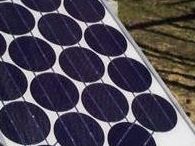Crystalline silicon solar cells
Historically, crystalline silicon (c-Si) has been the most used semiconductor in solar cells, even though it is a relatively poor absorber of light and requires a considerable thickness (several hundred microns) of material. Nevertheless, it has proved convenient because it yields stable solar cells with good efficiencies (11-16%, half to two thirds of the theoretical maximum), and uses process technology developed from the huge knowledge base of the microelectronics industry [1].
Two types of crystalline silicon are used in the industry. The first is monocrystalline, produced by slicing wafer (up to 150 mm diameter and 350 microns thick) from a large single crystal ingot grown at around 1400 oC, which is a very expensive process. The silicon must be of a very high purity and have a near perfect crystal structure. An example of single crystal solar cells is shown in Fig.1.

Fig.1 Single crystal silicon solar cells. (Taken from Ref.[2]).
The second type is multicrystalline silicon, made by sawing a cast block of silicon into bars first and then wafers. Solar cells made from single crystalline wafers are generally considered to be too expensive for large-scale mass production. This is the reason why the trend in crystalline silicon cells manufacturing is mainly turning towards polycrystalline technology, although resulting cells are not as efficient as single crystal silicon. Fig. 2 shows an example of polycrystalline solar cells.
![]()
Fig.2 Polycrystalline solar panel. Taken from Ref.[2]).
References
[1] Website http://www.solarbuzz.com/technologies.htm
[2] Website http://www.esdalcollege.nl/eos/vakken/na/zonnecel.htm
